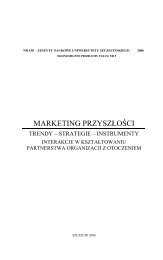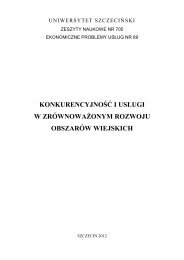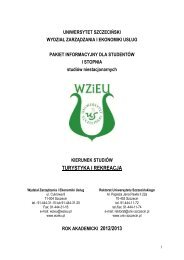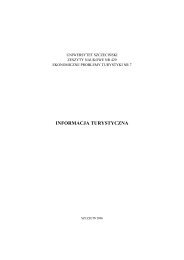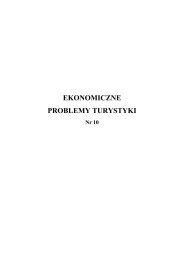Zeszyt naukowy - caÅoÅÄ - WydziaÅ ZarzÄ dzania i Ekonomiki UsÅug
Zeszyt naukowy - caÅoÅÄ - WydziaÅ ZarzÄ dzania i Ekonomiki UsÅug
Zeszyt naukowy - caÅoÅÄ - WydziaÅ ZarzÄ dzania i Ekonomiki UsÅug
You also want an ePaper? Increase the reach of your titles
YUMPU automatically turns print PDFs into web optimized ePapers that Google loves.
106<br />
Amanda Mieze<br />
Riga – the city of inspiration – is one of the slogans currently used by the city<br />
government. The Long-Term Development Strategy of Riga until Year 2025<br />
stresses the geographic location of Riga, emphasizing the fact that the city will develop<br />
as the cultural, educational and tourism centre of the Baltic region. Implementation<br />
of the Strategy is ensured by The Development Programme of Riga for<br />
2006–2012 which indicates that the city’s economic competitiveness and international<br />
identity will be promoted by culture and tourism – they will serve as a source<br />
of revenue and as a means of forming a positive image of the city 13 . The basic principles,<br />
goals and action targets for the development of tourism are defined in The<br />
Riga City Tourism Guidelines for years 2008–2012 14 . They suggest the vision for<br />
Riga as an attractive and diversified tourism destination, attracting foreign and domestic<br />
tourists by forming of the city’s image, informing about tourism opportunities<br />
and offering a variety of tourism products in a secure and orderly environment.<br />
Also Riga’s Tourism Coordination and Information Centre has been working since<br />
2002 – it renders information about tourism offers to travelers.<br />
Riga is the most important tourist destination of Latvia. According to Central<br />
Statistical Bureau 15 (CSB) data 34% of lodging capacity in 2008 was concentrated<br />
in Riga and two thirds of foreign guests have chosen to stay there overnight. Also<br />
the number of lodging units, the number of guests serviced and the number of services<br />
offered since 1991 has increased every year. During the last ten years the<br />
lodging capacity in Riga has doubled while the number of overnight visitors has<br />
tripled. The main target markets for Riga in the year 2008 were mainly European<br />
countries – Germany, Lithuania, Finland, Estonia, Russia, Sweden, Norway and<br />
Great Britain.<br />
Traditionally tourism in Riga has been based on its cultural and historical<br />
resources and architectural attractions which are primarily located in Old Town 16 .<br />
The historic centre of the city is listed as part of UNESCO’s World Heritage sites<br />
because of unique and preserved structure of town planning. Also more than one<br />
third of Old Town buildings are built in well known art nouveau architecture thus<br />
representing Riga as one of the main European art nouveau centers. There are more<br />
than 50 museums in the capital and the thematic range of them is extensive – they<br />
cover branches such as history, art, literature, medicine and nature. Riga also has<br />
deep theatre traditions – 5 repertory theatres and 5 music institutions, including The<br />
Latvian National Opera work in the city. The National Song and Dance Festival<br />
which takes place every four years is recognized by UNESCO as a unique cultural<br />
13<br />
Development Program of Riga for 2006–2012, Riga City Council, 2005.<br />
14<br />
The Riga City Tourism Guidelines for years 2008–2012, www.riga.lv, 15.01.2010.<br />
15<br />
www.csb.gov.lv, 15.01.2010.<br />
16<br />
M. Rozite, Tourism Development, Pitfalls and Future Opportunities in Riga – the City of<br />
Inspiration, University of Latvia, Riga 2008.



